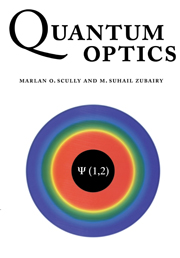Book contents
- Frontmatter
- Contents
- Dedication
- Preface
- 1 Quantum theory of radiation
- 2 Coherent and squeezed states of the radiation field
- 3 Quantum distribution theory and partially coherent radiation
- 4 Field–field and photon–photon interferometry
- 5 Atom–field interaction – semiclassical theory
- 6 Atom–field interaction – quantum theory
- 7 Lasing without inversion and other effects of atomic coherence and interference
- 8 Quantum theory of damping – density operator and wave function approach
- 9 Quantum theory of damping – Heisenberg–Langevin approach
- 10 Resonance fluorescence
- 11 Quantum theory of the laser – density operator approach
- 12 Quantum theory of the laser – Heisenberg–Langevin approach
- 13 Theory of the micromaser
- 14 Correlated emission laser: concept, theory, and analysis
- 15 Phase sensitivity in quantum optical systems: applications
- 16 Squeezing via nonlinear optical processes
- 17 Atom optics
- 18 The EPR paradox, hidden variables, and Bell's theorem
- 19 Quantum nondemolition measurements
- 20 Quantum optical tests of complementarity
- 21 Two-photon interferometry, the quantum measurement problem, and more
- Index
6 - Atom–field interaction – quantum theory
Published online by Cambridge University Press: 05 June 2012
- Frontmatter
- Contents
- Dedication
- Preface
- 1 Quantum theory of radiation
- 2 Coherent and squeezed states of the radiation field
- 3 Quantum distribution theory and partially coherent radiation
- 4 Field–field and photon–photon interferometry
- 5 Atom–field interaction – semiclassical theory
- 6 Atom–field interaction – quantum theory
- 7 Lasing without inversion and other effects of atomic coherence and interference
- 8 Quantum theory of damping – density operator and wave function approach
- 9 Quantum theory of damping – Heisenberg–Langevin approach
- 10 Resonance fluorescence
- 11 Quantum theory of the laser – density operator approach
- 12 Quantum theory of the laser – Heisenberg–Langevin approach
- 13 Theory of the micromaser
- 14 Correlated emission laser: concept, theory, and analysis
- 15 Phase sensitivity in quantum optical systems: applications
- 16 Squeezing via nonlinear optical processes
- 17 Atom optics
- 18 The EPR paradox, hidden variables, and Bell's theorem
- 19 Quantum nondemolition measurements
- 20 Quantum optical tests of complementarity
- 21 Two-photon interferometry, the quantum measurement problem, and more
- Index
Summary
In the preceding chapters concerning the interaction of a radiation field with matter, we assumed the field to be classical. In many situations this assumption is valid. There are, however, many instances where a classical field fails to explain experimentally observed results and a quantized description of the field is required. This is, for example, true of spontaneous emission in an atomic system which was described phenomenologically in Chapter 5. For a rigorous treatment of the atomic level decay in free space, we need to consider the interaction of the atom with the vacuum modes of the universe. Even in the simplest system involving the interaction of a single-mode radiation field with a single two-level atom, the predictions for the dynamics of the atom are quite different in the semiclassical theory and the fully quantum theory. In the absence of the decay process, the semiclassical theory predicts Rabi oscillations for the atomic inversion whereas the quantum theory predicts certain collapse and revival phenomena due to the quantum aspects of the field. These interesting quantum field theoretical predictions have been experimentally verified.
In this chapter we discuss the interaction of the quantized radiation field with the two-level atomic system described by a Hamiltonian in the dipole and the rotating-wave approximations. For a single-mode field it reduces to a particularly simple form. This is a very interesting Hamiltonian in quantum optics for several reasons. First, it can be solved exactly for arbitrary coupling constants and exhibits some true quantum dynamical effects such as collapse followed by periodic revivals of the atomic inversion.
- Type
- Chapter
- Information
- Quantum Optics , pp. 193 - 219Publisher: Cambridge University PressPrint publication year: 1997
- 4
- Cited by



